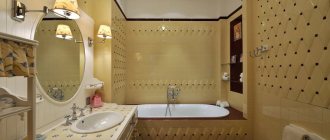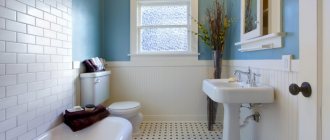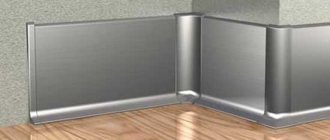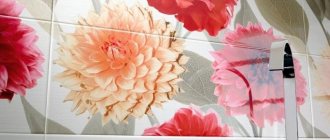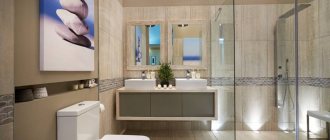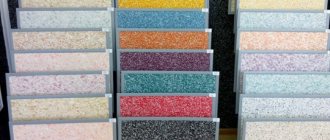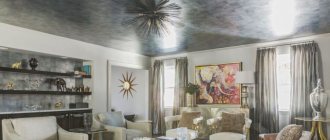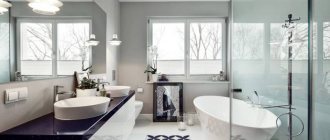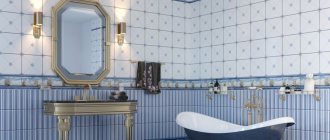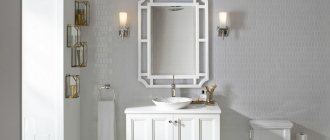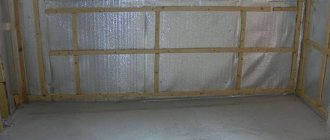Previously, the ceiling in the bathroom and toilet was simply whitewashed with lime. But this is not the best and most reliable finish for a room with such a microclimate. Currently, there are many building materials on sale that make it possible to create durable cladding that has the properties necessary for such conditions. In this article we will take a detailed look at what is best to make a ceiling from so that it lasts a long time, we will analyze the pros and cons of each option, as well as the nuances of installation.
General requirements for finishing materials for the bathroom
The bathroom is characterized by high humidity and relatively high air temperatures due to hot pipes. Therefore, a number of requirements are imposed on finishing materials:
- lack of a breeding ground for microorganisms - fungi and bacteria, which are dangerous to human health and have a destructive effect on building materials;
- resistance to heat and moisture, especially in the shower - these conditions should not lead to changes in the appearance of the skin, otherwise repairs will need to be done quite often;
- strength - we are talking about premises for sanitary procedures and household purposes, so we need high-quality materials that can withstand the strength test and are resistant to mechanical stress;
- resistance to powders, detergents, including those containing abrasives, alkalis and acids;
- easy care - the surface should be well cleaned and, if necessary, tolerate disinfection.
It is desirable that the design provides quick access to communications that may pass under the ceiling.
No. 4. Dropped ceilings
Today, suspended ceilings often mean slabs, slats, lining, modules made of plastic, plexiglass, metal, etc. attached to a frame. There are a lot of possible options, but it is important that the material is moisture resistant and matches the interior.
The undoubted advantage of such ceilings is that no additional priming or painting is required, as is the case with plasterboard. The finishing material already has an attractive appearance, with which you can create a unique interior in the bathroom. In addition, any suspended ceiling can be equipped with built-in lighting, all communications can be hidden under the structure, providing the most attractive appearance of the entire structure.
Among the disadvantages, one can note the fact that the room will become 10-15 cm lower. Moreover, often the cost and installation of a suspended ceiling is quite expensive, and the simplest cellular or cassette ceilings will not give the bathroom the proper home comfort, reminiscent of an office or public toilet.
Materials to be used with caution
Now let's look at materials that are also suitable for finishing a bathroom, but with a number of restrictions.
Cork panels
The cork-covered ceiling looks interesting. It is made from pressed bark and cork oak veneer. Slabs that can be used for a bathroom are covered with a layer of wax on top. The finishing design is not as monotonous as it might seem: manufacturers produce tinted collections.
Cork slabs are presented mainly in two sizes: 30x30 and 30x60 cm. The standard thickness is 3 mm.
This environmentally friendly material has several advantages:
- attractive appearance;
- additional heat and sound insulation;
- hypoallergenic;
- resistance to rotting;
- wear resistance.
The coating has antibacterial properties, so fungus does not appear on the walls even in conditions of high humidity. Another advantage of the panels is that they can be washed with water.
The disadvantage is the porous structure, which allows odors to be absorbed. But this disadvantage is offset by the wax coating.
Installation of tiles is quite simple. First they make the markings. If the sticking is from the center, find this point. Then apply glue (preferably moisture-resistant) to the base and back side of the tile, apply each element and pass over it with a rubberized roller. If it was not possible to find material with a waxed surface, after completion of the work the ceiling is varnished.
Foam tiles
Budget renovations in the bathroom can be done using ceiling tiles. It consists of square panels, most often 50x50 cm in size and about 8 mm thick, made of polystyrene foam and polystyrene foam. The surface can be smooth or with a relief pattern, like modeling.
They produce paintable tiles and laminated products that imitate wood, stone, fabric, leather and other materials. The first type is only white, as a rule, made from foam plastic raw materials and requires finishing with paint and varnish. Laminated tiles have a moisture-resistant protective layer and do not require painting. This type of material is recommended for the bathroom.
The tiles can also be suture or seamless. The first has a small chamfer along the edges, which forms decorative seams, the latter forms a continuous covering on the ceiling, the joints are invisible.
Finishing has its advantages:
- ease of installation - the task can be done even by those who have not done repairs before;
- light weight;
- low cost.
Disadvantages include:
- short service life - up to 6 years;
- the appearance of mold at the joints, so the ceiling needs to be treated with antiseptic impregnations;
- there is no protection against leakage;
- difficulty in cleaning, especially products with a relief pattern that imitates modeling.
Installation of tiles is almost the same as cork panels. If you take non-laminated products, they must be painted with waterproof paint.
Paint and whitewash
This method of repair is resorted to only to save money. Whitewashing the ceiling in the bathroom with lime or chalk does not last long due to high humidity. Therefore, the coverage must be renewed annually. Before finishing, you will have to carefully level the base with a layer of plaster, since even the slightest imperfections will be noticeable.
But if another method is not suitable for some reason, then it is better to select paints with water-repellent properties that can be washed. This is a more practical option, but the finish will still have to be updated over time.
Water-repellent paints include:
- Acrylic - characterized by high viscosity, hides small defects, and has shown excellent results on wooden surfaces. Withstands 1500 wash cycles.
- Latex - used in rooms with a high degree of pollution. The coating can be so durable that it can even be rubbed with a brush and cleaned with household chemicals.
- Silicate - products based on silicate glass. They have increased water resistance while remaining vapor permeable. Prevents the formation of mold and mildew. But these paints are not recommended for use on loose, overly porous surfaces.
Tree
The ceiling is often covered with clapboard, especially in rooms decorated in a rustic style. This material is afraid of moisture and is susceptible to rotting, so it is better to limit its use.
To make the wooden ceiling in the bathroom last longer, you need to consider the following points:
- it is important to choose the right type of wood - preferably Finnish spruce, pine, cedar, alder, teak;
- The lining made from the core of the trunk performed better - it cracks less;
- treatment with water-repellent impregnation is required;
- Between the ceiling and the lamellas there should be gaps for ventilation, which will ensure the evaporation of excess moisture and drying of the wood.
Read more: Wooden ceiling in the bathroom
Decorative plasters
Another very popular finishing method, which is valued for the beauty of the relief, or the pattern formed as a result of grouting. But such a surface is difficult to care for.
If you still want to decorate the bathroom ceiling with decorative plaster, then you need to choose acrylic or silicone products that are water-resistant. They contain polymer moisture-resistant additives.
It is recommended to apply hydrophobic paint, varnish or wax on top. And when decorating, give preference to smoother reliefs, for example, Venetian plaster.
Moisture-resistant wallpaper
Sometimes the ceiling in the bathroom is decorated with wallpaper. The main requirement for them is moisture resistance. Vinyl and non-woven wallpaper have this property; glass wallpaper is considered the best option.
It is important to choose the right glue. It must not only match the type of material, but also have water-repellent properties. For wallpaper, waterproof paints and varnishes are used for painting.
Deciding what ceiling to make in the bathroom
Choosing a ceiling from a design point of view
As already mentioned, first think about how the design of your ceiling (and the entire bathroom) will combine with the interior of the apartment. Well, for example, “classic” is the snow-white version. Moreover, it can be a tensile structure, plasterboard, hemmed or suspended, with or without built-in lamps. A flat and smooth white surface (perhaps even just painted) fits wonderfully into any interior. The combination of a white ceiling and black floor (and sometimes walls) looks especially chic.
Using textured ceilings, you can “play” with the size of the bathroom, making it visually wider or narrower, higher or lower. These include modular, tile, rack, and cellular type structures. All of these ceilings have a strongly pronounced texture of planks or tiles.
If the bathroom is large, then multi-level ceilings can be used. The easiest and cheapest way to make them is from plasterboard. It would look good, for example, a round convex structure with lamps located above a round-shaped bathtub.
Which option will you choose from a practical point of view?
If we consider which ceiling in the bathroom is better not from a design point of view, but from the practicality of the ceiling covering, then stretch ceilings and ceilings made of PVC panels definitely come out on top. A stretch ceiling for a bathroom is simply ideal. It’s not for nothing that more and more people choose this option. Thin but waterproof PVC film is both practical and beautiful.
If you notice an error, a non-working video or link, please select a piece of text and press Ctrl+Enter .
0
Which material is better to choose
There is no clear answer to this question. There is no ideal. But you can purchase a finish with the maximum range of useful characteristics. A comparison table of the properties of different materials will help you decide which ceiling is best to choose for the bathroom.
| Material name | Service life, years | Hiding communications | Possibility of washing with household chemicals | Variety of designs | Access to communications | Retains water when flooded | Self-installation | |
| Ceramic tile | From 10 | No | Yes | Yes | No | No | Yes | |
| PVC panels | From 10 | Yes | Yes | Yes | Yes | No | Yes | |
| Tension fabrics (PVC) | From 10 | Yes | Not all means are suitable | Yes | Yes | Yes | No | |
| Glass and mirrors | From 15 | Depends on installation method | Yes | Yes | Depends on installation method | No | Yes | |
| Acrylic slabs | From 10 | Yes | No | Yes | Yes | No | Yes | |
| Drywall | From 5 | Depends on installation method | Depends on finish | No | No | Yes | ||
| Aluminum slatted ceiling | From 15 | Yes | Yes | Yes | Yes | No | Yes | |
No. 3. Plastic panels
This finishing option can be called the golden mean in terms of price-appearance ratio . PVC panels have a lot of advantages , the most important of which are:
- absolute moisture resistance and strength;
- You can even do the installation yourself;
- externally, this is a wonderful stylish finish that does not require additional processing, like drywall, for example. If installed correctly, the ceiling will look monolithic, and the joints of the panels will be impossible to recognize with the naked eye;
- You can install spotlights in such a ceiling if such lighting matches your design idea;
- the finish is very easy to maintain;
- relatively low price, which allows us to classify this option as a budget solution. If the installation is carried out independently, then the cost of such finishing is generally minimal.
Not without its drawbacks:
- if the ceiling is not assembled very skillfully, then the joints of the panels will be visible. But that's not so bad. Dirt and moisture will gradually begin to get into such joints, provoking the development of mold in the absence of proper ventilation;
- the metal frame to which the plastic plates are attached may rust over time, even with a galvanized coating. But if everything is in order with ventilation in the bathroom, then this should not happen;
- It will not be possible to quickly update the coating, as in the case of painting, for example - you will have to dismantle the old panels, and only then organize a new finish.
Some interesting design solutions to help
If you still haven’t decided what kind of ceiling you will have in the bathroom, then here is a small selection of original compositions from the arsenal of designers around the world.
